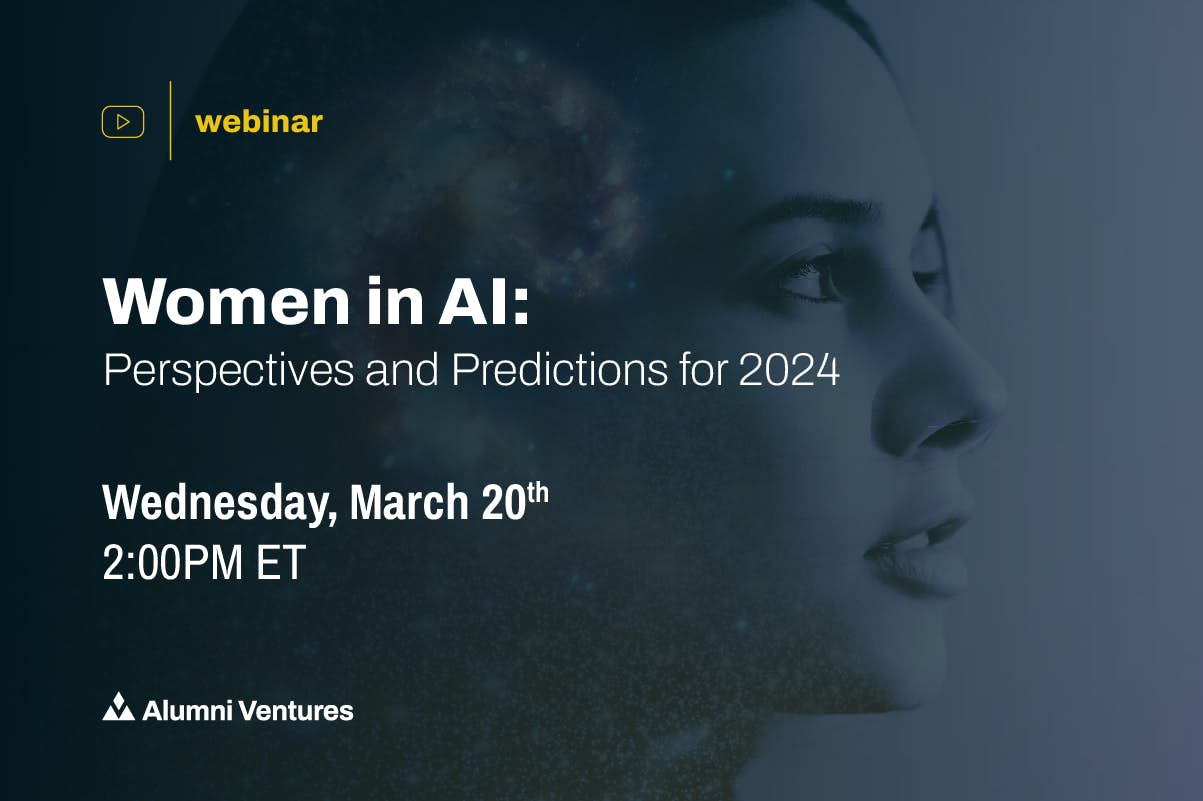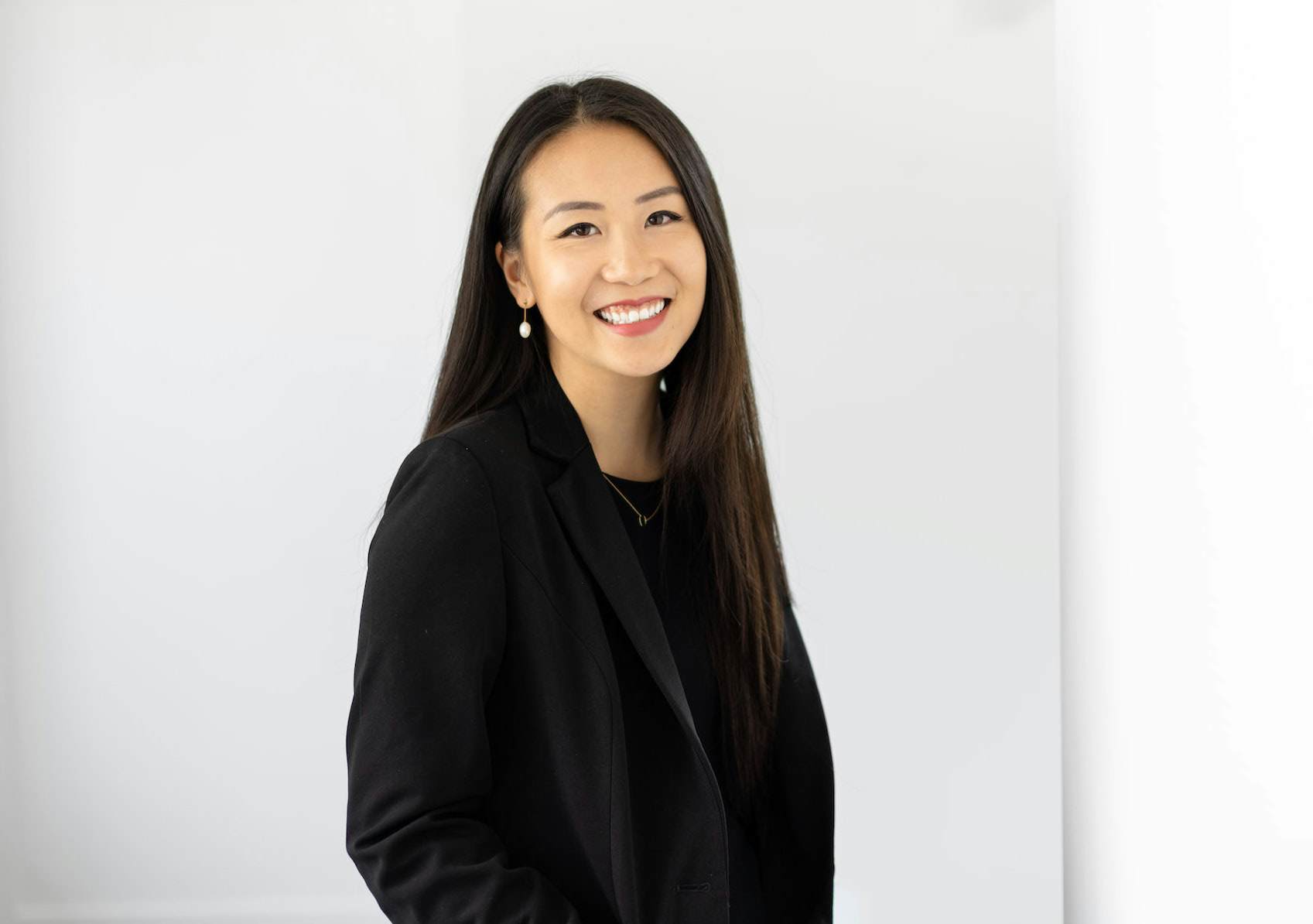Women in AI
Perspectives and Predictions for 2024

The underrepresentation of female leaders in the technology sector is glaringly evident in instances like The New York Times’ article titled “Who’s Who Behind the Dawn of the Modern Artificial Intelligence Movement,” where only male figures were acknowledged. This recent oversight underscores the pressing need to recognize and embrace diversity within the AI field. Beyond the imperative of equality, acknowledging and amplifying the contributions of women in AI is vital for attracting a diverse pool of talent and addressing the inherent risks of biases in AI systems.

Sophia Zhao
Venture CapitalistSophia Zhao is a member of AV’s Women’s Fund team, as well as the AI Focused Fund team. She brings over a decade of experience working in tech and finance with a focus on Web3 and AI in recent years. Sophia is an alumna of Yale School of Management and the University of British Columbia.
As I perused my news app in December last year, my excitement surged when I discovered The New York Times article, “Who’s Who Behind the Dawn of the Modern Artificial Intelligence Movement.” I happily tapped into the article only to find my smile disappearing — astonishingly, not a single woman was acknowledged on the list.
What the heck was the New York Times thinking? On top of my head, I can think of two women immediately. One is Dr. Fei Fei Li, the inaugural Sequoia Professor in the Computer Science Department at Stanford University and Co-Director of Stanford’s Human-Centered AI Institute. The other was Sara Hooker, the Head of Cohere for AI at our portfolio company Cohere, which develops AI for enterprise use by using large language models. That’s not to mention many other female talents within my network and community.
Excluding women from the list of top AI influencers misrepresents talent and reinforces the damaging stereotype that AI is a male-dominated domain. That sends a discouraging message to women aspiring to a career in AI.
To help correct this image, we’re Introducing our new blog series focused on spotlighting Women in AI — which we hope to add to. Our aim is to celebrate, raise awareness, and inspire more women to join the field. In this inaugural article, we are privileged to showcase the accomplishments of five remarkable women. Let’s delve into their stories.
Learn More about the AI Fund
We are seeing strong interest in this fund as prior AI Fund vintages were oversubscribed, and we’ve had to establish a waitlist to accommodate interest.
If interested, we recommend securing a spot promptly.
Max Accredited Investor Limit: 249
LAUREN KOLODNY
Founding Partner Acrew Capital, Alumni Ventures Board Observer
We think a lot about how we can leverage AI to support our investing process and business operations, and make us even more impactful in supporting our companies.
Q: Tell Us About Your Current Role.
Since 2019, I have helped build and manage Acrew Capital with my partners, where I am a Co-Founder and Managing Partner. Acrew is a thesis-driven firm that invests in three main areas: fintech (my investment focus), data and security, and consumer networks. Acrew has nearly $2 billion in assets under management, and we invest out of two funds: Long Term View is dedicated to early-stage ventures and Diversify Capital Fund targets growth-stage opportunities, Series B and beyond. We believe that, no matter what stage your company is, we can help.
Q: Can you share your AI insights and experiences?
We think a lot about how we can leverage AI to support our investing process and business operations and make us even more impactful in supporting our companies.
To date, ChatGPT has been helpful for gleaning quick context when evaluating new industries or complex topics in our thesis work. It is a powerful tool and is only getting stronger.
We are also in the early days of working with a tool that reviews proprietary and market data to generate signals on trends or patterns relevant to our investment process. This solution seems like a promising addition to investor workflow at Acrew, helping us to be even more thesis-driven. We continue to push internally on how to automate or optimize other tasks.
Q: What would you suggest to those interested in transitioning into a career in AI?
- Conduct a skills assessment: Evaluate your existing skills and consider how they might be applicable to AI. The answers to these might be surprising: knowing how to structure requests in natural language can be just as valuable as writing code for certain AI roles.
- Gain practical experience: While some AI tools require advanced technical knowledge, others can be accessed with foundational skills (familiarity with programming languages, understanding basic statistics and linear algebra, proficiency in data manipulation and analysis), though a solid foundation in math and coding is beneficial.
- Stay current on the latest research: AI is evolving rapidly, and it is essential to know what’s happening in the field so you can speak confidently about the strengths, weaknesses, limits, and opportunities of different AI tools.
Q: What is your AI Prediction for 2024?
The intersection of AI and financial services continues to evolve, but some early use cases have begun to take shape. This is what has caught the attention of my team at Acrew so far:
- Fraud detection: This will be an ongoing challenge for any financial institution, and AI has a clear role in uncovering suspicious activity and transactions (especially as AI will increasingly be required to combat fraud being generated by AI). Existing startups have been attracting investor attention.
- Financial coaching: This has been an opportunity for chat assistants for years, but hasn’t yet achieved liftoff. With recent advances in technology, there is now greater potential to help consumers (and businesses) navigate complex financial decisions. Will this create standalone opportunities like a new personal finance app, or will this become a feature of financial platforms? And how will the industry differentiate between giving support vs. giving advice: will AI be taking a Series 65 exam?
- Financial data/analytics: This is an area with huge potential for AI to automate research and even analysis, even at a basic level.
RASHMI GOPINATH
General Partner at B Capital
I have been investing in AI for the last eight years and am excited about the potential of AI to radically transform the way we work and live in the coming years.
Q: Tell Us About Your Current Role.
I am a General Partner at B Capital, heading the fund’s global enterprise software technology investments for the last four years. In my role, I lead investments across a number of software sectors, such as cloud infrastructure, cybersecurity, data infrastructure & AI, and application software. Prior to B Capital, I was in a similar role at M12, Microsoft’s venture fund, for over four years, and before that, at Intel Capital.
I spent the first half of my career in operating roles both at large companies and startups. I began in product and engineering roles, building software products for Oracle and GE Healthcare. Then, I led go-to-market roles at a seed-stage cloud infrastructure startup, BlueData, that was acquired by HPE, and then at a growth-stage database startup, Couchbase, that went public a few years back.
Q: Can you share your AI insights and experiences?
I have been investing in AI for the last eight years and am excited about the potential of AI to radically transform the way we work and live in the coming years. GenAI has accelerated the pace of innovation in AI, and recent innovations have already significantly impacted our productivity and efficiency by automating repetitive, tactical tasks — allowing us to focus on higher-order, complex tasks, and processes. I’ve celebrated the successes of numerous startups that I’ve backed in the AI infrastructure and applications sectors, which have made a meaningful impact on their customers.
I advise professionals considering AI as their career choice to remain technically curious, be open to rapid transformation and change, and be focused on end-user ROI. AI is not a solution in itself, but it can be a key foundational piece in helping solve real pain points for several industries and sectors.
Q: What is your AI Prediction for 2024?
Given the widespread adoption of foundational models and generative AI, we’ve already seen the impact of significant tailwinds in AI. The ease and simplicity of AI being accessible to a wider set of non-technical audiences will be quite profound. AI will be pervasively available across the vast majority of software and hardware applications.
My predictions for AI in 2024 are:
- We’ll see the emergence and shift from Large Language Models to Small Language Models or contextual models that will be cost- and resource-efficient, with a higher degree of accuracy for enterprise use cases.
- An intersection of blockchain and AI will emerge that will enable new approaches for training data/content monetization and model authentication.
- Increased federal and national spending on AI will spur innovation across multiple geographies and have a measurable impact on GDP and economic growth.
SARA HOOKER
Head of Cohere for AI, Cohere
My work centers around improving model efficiency training techniques and optimizing for models that fulfill multiple desired criteria — interpretable, efficient, fair, and robust.
Q: Tell Us About Your Current Role.
I lead Cohere For AI, a non-profit research lab under Cohere that seeks to solve complex machine learning problems. Our lab supports fundamental research that explores the unknown and focuses on creating more points of entry into machine learning research. My work centers around improving model efficiency training techniques and optimizing for models that fulfill multiple desired criteria — interpretable, efficient, fair, and robust.
Q: Can you share your AI insights and experiences?
To date, the majority of AI and machine learning research has come from a small handful of labs and researchers with a deep background in the industry, which isn’t necessarily conducive to real progress and breakthroughs. However, this is slowly changing. At Cohere For AI, we’ve focused on addressing that, broadening access to AI and machine learning research so that the best minds from all backgrounds, including nontraditional ones like mine, can participate.
For example, our Scholars Program is designed to provide alternative points of entry into research for emerging talent from around the world. Part of the criteria for our inaugural cohort was that applicants could not have previously published a machine learning research paper. We’re also working to help bridge the compute gap faced by independent researchers across the globe by offering research grants to access frontier models at Cohere.
Q: What is your AI Prediction for 2024?
The past year has seen incredible innovation in AI, and I expect even more in 2024. Yet, while the technological developments have been remarkable, when it comes to culture, language, and geography, it is still less inclusive than it should be. The development of models and the datasets used for training have remained biased towards English-speaking and Western European countries, offering little representation of languages from the Global South or Asia.
- In 2024, I believe we’ll make progress in closing this language gap and strengthen our collective effort to incorporate research, training data, and individuals from across the globe. This will include projects like Aya, a model that we are releasing that will cover 101 languages. Bridging the gap is not just a matter of inclusivity; it’s key to unlocking the transformative power of AI and ensuring that it can serve a global audience — irrespective of language or cultural background.
- 2024 will also be a year for research bets. Models will become more akin to our human intelligence, able to process multiple sensory inputs at once. We’ll also focus on the size of models — looking for efficiency rather than size — as it becomes critical to deploy models that are available in resource-constrained environments. Our lab is already pushing the limits of efficiency at scale and adaptive computing (both data pruning and the mixture of experts).
SANJANA BASU
Investor at Radical Ventures
I believe in the deeply disruptive power of AI to create massive value across sectors. I focus on technically differentiated teams building applied AI businesses.
Q: Tell Us About Your Current Role.
I’m an AI investor and have been at Radical Ventures since 2019. I believe in the deeply disruptive power of AI to create massive value across sectors. I focus on technically differentiated teams building applied AI businesses at Radical Ventures. I’ve been involved with Radical’s investments in Orbital Materials, Nabla Bio, Lisa Health, PocketHealth, Signal 1, Synex, and Ubenwa.
Before joining Radical, I invested in various deep tech and consumer tech businesses at the venture arm of the Global Indian Conglomerate, the Tata Group. Before that, I was an Investment Banker at Barclays in Mumbai.
I was born and raised in Mumbai, India. I’ve completed my MBA from the Indian Institute of Management (IIM), Bangalore, and received my undergraduate in Economics & International Relations from Tufts University in Boston.
Q: Can you share your AI insights and experiences?
The single most important thing I look for when evaluating AI companies is talent. AI founders innovating at the frontier should leverage their networks to build a unique talent moat. AI talent is scarce, and founders who can assemble teams with unique knowledge of the problem they are trying to solve and relevant technical experience create immediate value for the company. Top AI teams should also be complemented by domain experts with experience building and selling in the specific sector, especially in companies leveraging AI to unlock value in specific verticals.
Q: What is your AI Prediction for 2024?
AI for sciences will gain more momentum and attention. Generative AI applied to biology, chemistry, and physics will be some of the largest value categories to emerge in the future.
Technical innovations in these areas have been around for years (e.g., AlphaFold). But there’s a stark change in adoption as the technology has evolved. The industry has matured in its buying appetite for AI, and talent from top labs is spreading its wings to start new companies.
VIVIEN HO
Partner at Pear VC
I’ve been really excited to fund technical female founders building in AI. We need to encourage an inclusive environment to empower women in AI.
Q: Tell Us About Your Current Role.
I am a Partner at Pear VC, investing in human and planet health. I joined Pear as a Fellow while pursuing my MBA at Wharton and worked part-time for two years and during my summer internship. After spending time at larger companies like Airbnb and BCG, I wanted to work directly with founders at the earliest stages. I loved interacting with pre-seed founders and meeting brilliant entrepreneurs, and I realized it was my dream job.
Five years later, I lead our healthcare and climate practice at Pear VC and spearhead our Female Founder Circle program for female engineers. This is just the beginning of many years of supporting entrepreneurs who are looking to make a positive dent or crater in the universe!
Q: Can you share your AI insights and experiences?
We’ve been investing at the forefront of AI applications for some of the most important sectors for humanity — whether it is reducing the administrative burden for burnt-out clinicians such as Abstractive Health, developing better cancer treatment decisions to improve outcomes such as Valar Labs, or accelerating funding for crucial climate technologies such as Streamline Climate.
At Pear, we look for multidisciplinary teams. For example, in healthcare looking for teams with both the clinician expertise as well as the technical AI DNA. The space is moving at breakneck speed, so it’s important to keep up with the latest developments to ensure your company continues to build defensibility. At the same time, the path to product-market fit remains the same, the industry expertise, the right customer networks, and understanding real customer needs and attention to detail on the UX are still crucial to build a strong product.
I’ve been really excited to fund technical female founders building in AI since the percentage of women in AI has already fallen behind. Globally, 22% of AI employees are female, and only 12% of artificial intelligence researchers are female. We need to encourage an inclusive environment to empower women in AI. We need to encourage models built on reducing bias.
Q: What is your AI Prediction for 2024?
2024 is the year AI can be truly implemented in heavy services businesses such as healthcare and climate-related industries. There is so much opportunity to leverage multi-modality, agent-based, and voice-based AI models to automate repetitive or time-consuming workflows, improve customer or patient support, and drive better outcomes and better margins. For example, hospitals and long-term care facilities have been really impacted by the pandemic and can leverage true robot process automation or tools to support frontline healthcare workers.
Let Us Hear From You
Thank you for reading our first article on Women in AI. Connecting with and interviewing these exceptional women leaders who are pioneering the frontier of AI has been an honor. These women, alongside numerous others, are not only influencing the future of AI but have also played a pivotal role in establishing foundational practices for AI across various industries.
Since 2014, Alumni Ventures has invested over $200M across 350+ investments into female founders and CEOs, representing over 26% of AV’s portfolio. These investments span key sectors such as healthcare, consumer, fintech, and more. We are proud of our commitment to supporting women entrepreneurs.
If you have someone you’d like to nominate for this series — including yourself — please reach out to [email protected]
Learn More about the AI Fund
We are seeing strong interest in this fund as prior AI Fund vintages were oversubscribed, and we’ve had to establish a waitlist to accommodate interest.
If interested, we recommend securing a spot promptly.
Max Accredited Investor Limit: 249





